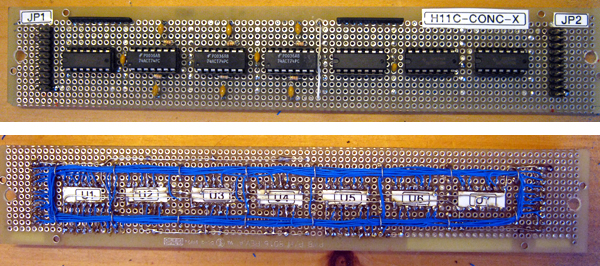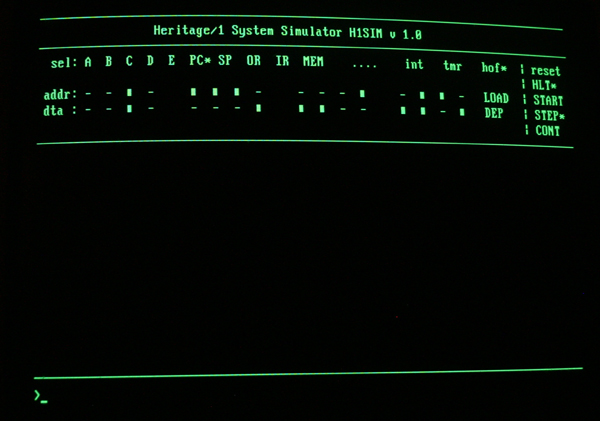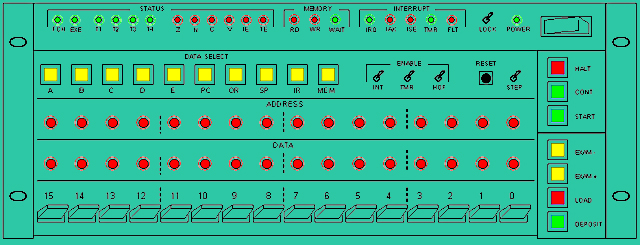Hardware development on hold6/19/2010
Debouncer board (H11C-CONC-X) was finished last night, being this the last hardware-related job until September. Hardware development is now on hold for the next two month.
Software and design related tasks, however, will continue; such as the production of the H1ASM assembler and the H1SIM simulator, and the re-design of the Master Controller board among others.
Reviewing the Instructions Set Architecture
06/20/2010
The current Instructions Set Architecture was designed nine months ago based on my early ideas about how instructions would be decoded using hardwired logic. I still think it's not a bad design, but it needs some adjustments and that's exactly what I am doing.
The new architecture relies, pretty much, on the same ideas, but it makes better use of bit-fields and it's better oriented to the decoding circuitry (yet to come). It is more rational, I think, and it also makes room for new instructions that I have in mind such as those for ALU operations with memory (not allowed by the current ISA) and increment/decrement instructions optimized for typical loops.
It is still pending how to produce long sequences such as the ones required for CALL and RET instructions (longer than 4 clock periods) but... I'm working on it.
The new (revised) Instructions Set is complete
06/26/2010
Finished to define and document the (revised) Instructions Set Encoding. It wasn't too hard but it was very tedious...
Also got to a solution for long sequences (instructions CALL, RET and INT) which take 8 cycles to execute instead of 1 to 4 cyles that all other instructions take.
Here is the resulting document:
http://www.armandoacosta.com/cpu/index.php?branch=576
Migrating to MS-DOS
06/27/2010
A few days ago I installed MS-DOS 6.22 on an old Pentium PC that I have and then copied to its hard drive my "glorious" probation of DOS stuff from my backup CDs. Needless to say that DOS is a lovely environment for old-fashioned tech people such as my self, so I got fascinated with the result.
What I love of working with DOS (rather than Windows or Linux) is the simplicity. You get things done quick and almost effortlessly; you have fewer choices so fewer things to worry about; you can focus on what you are doing with no distractions.
I was planing for C but the Microsoft Quick C ver 2 (QC2) that was once my war horse, were corrupted so for development I only have a copy of Borland Turbo Pascal 3.0... very limited but good enough for producing my assembler/simulator winning couple.
So it is decided: DOS will be the development environment for Heritage/1 software production. H1ASM will be rewritten in Turbo Pascal taking advantage of the good experience I had with the PHP implementation. The H1SIM simulator will also be written in Turbo Pascal... for DOS!
Working hard on the Simulator
7/8/2010
This simulator written in Turbo Pascal 3.0 proven easier than expected. In only six days (or nights...) of development it got to Fetch and Execute "real code" previously read into "memory" from a hex file.
I wanted it to look primitive, even more primitive than those programs that I used to write with Turbo Pascal twenty years ago. The text-only interface resembles the computer's console in a direct way, no fancy debugging commands have been added other than the ability to read a hex file from disk.
This primitive design has resulted in an intimate experience, very close to the machine being emulated which Console is expected to look more or less like this:
This program does not mimic the Heritage/1 exact circuits but only its behaviour. Hower, it resembles the hardware architecture at the block level, implementing in software the same solutions as in hardware. This match between software and hardware is giving me the oportunity to test those solutions on cold... which wasn't my initial intention, I have to confes...
Finished ISA review
7/15/2010
This simulator has proven to be a great "prove of concept" tool. It helped me to find inconsistencies in my Instructions Set that was more than happy to fix right a way.
| 



